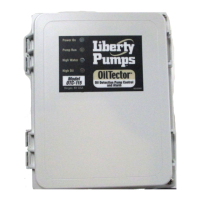7000 Apple Tree Avenue, Bergen, NY 14416 | Phone: (800) 543-2550 | Fax: (585) 494-1839 | www.LibertyPumps.com
1
Operation, Maintenance, and Installation Manual | 7613000A
OilTector
®
Control Panel System
Single Phase Simplex | Type 4X (Indoor/Outdoor)
Models: OTC Series, Opaque Door, Local and Remote Alarm
Read all instructions thoroughly. Installation of the OilTector® control system must comply with all federal, state, and local
codes, regulations, and practices. The control system must be installed by qualified personnel familiar with all applicable
local electrical and mechanical codes. Refer to the National Electrical Code (NEC) (NFPA 70). Failure to properly install and
test this product can result in personal injury or equipment malfunction.
The OilTector control system is designed and approved for the safe operation of pumping, alarming, and monitoring of
elevator sump pits, transformer vaults, and leachate well applications. The OilTector control panel will activate a pump to
remove water from pits in accordance with ASME A17.1, stopping the pump before oil or other harmful substances enter the
water supply. The control panel includes LED indicators that will illuminate while monitoring various conditions including
but not limited to: power, pump running, high oil, high water, power loss, level sensor error detection (if enabled), fire alarm
mode (if enabled), and low level alarm/redundant o (if enabled). The included alarm buzzer and/or auxiliary contacts will
activate on power loss, high oil, high water, or the various alarm conditions. The system also includes auxiliary contacts for
pump run monitoring. The alarm auxiliary contacts of the control panel are connected to the OilTector remote alarm panel
which provides audio and visual indication of an alarm condition with built-in auxiliary contacts for connection to a building
automation system (BAS) or SCADA system and phone dialers.
The OilTector control panel menu system with rotary encoder interface and OLED display screen provides indication of
the current system status and access to configurable features including: level sensor error detection, automatic or manual
alarm condition reset, function input to be used for a fire system or low level/redundant o float switch, and a weekly pump
exerciser. An integrated pump hand-o-auto (HOA) selector switch is included to set the desired operation mode of the
pump. Refer to additional information in this manual for: multiple auxiliary contact outputs, navigating menu system, change
system settings or configurations, system setup with the setup wizard, system displayed statistics, and user input presets.
Introduction
Safety Guidelines
1. DISCONNECT ALL ELECTRICAL SERVICE BEFORE WORKING ON OR HANDLING THE OILTECTOR SYSTEM.
2. DO NOT USE WITH FLAMMABLE OR EXPLOSIVE FLUIDS SUCH AS GASOLINE, FUEL OIL, KEROSENE, ETC.
DO NOT USE IN EXPLOSIVE ATMOSPHERES. SENSOR MODULE SHOULD ONLY BE USED WITH WATER.
3. DO NOT HANDLE THE OILTECTOR CONTROL SYSTEM WITH WET HANDS, WHEN STANDING ON A WET OR
DAMP SURFACE, OR IN WATER.
4. INCOMING VOLTAGE MUST MATCH OILTECTOR CONTROL SYSTEM VOLTAGE.
5. TO PREVENT ELECTRICAL SHOCK AND EQUIPMENT MALFUNCTION, USE ONLY WITH A PUMP SUPPLIED
WITH A GROUNDING CONDUCTOR AND GROUNDING-TYPE ATTACHMENT PLUG. MAKE SURE TO PLUG THE
OILTECTOR CONTROL PANEL INTO A PROPERLY GROUNDED, GROUNDING-TYPE RECEPTACLE.
6. CONTROL PANEL CAN BE MOUNTED INDOOR OR OUTDOOR. ALARM PANEL MUST BE MOUNTED INDOOR.
FOR OUTDOOR ALARM APPLICATIONS, CONSULT FACTORY.
7. SECURE THE PRESET LEVEL SENSOR MODULE ON THE DISCHARGE PIPE AT A LEVEL THAT GUARANTEES
PARTIAL PUMP SUBMERGENCE WHEN THE WATER LEVEL IS JUST BELOW THE PUMP STOP PROBE
(longest probe; see step 2 on page 5 of this manual). FAILURE TO PROPERLY MOUNT THE PRESET LEVEL
SENSOR MODULE MAY CAUSE UNINTENDED CONSEQUENCES.
8. CAUTION! REMOVE ANY FLOAT SWITCH THAT IS CURRENTLY USED OR SUPPLIED WITH THE PUMP. IF THE
FLOAT CANNOT BE REMOVED, SECURE FLOAT SWITCH SO THAT IT IS ALWAYS ON.
IMPORTANT
Refer to the included electrical schematic for all incoming power connections and pump connections which may include
optional field wiring connections. This manual covers models: OTC-115-230W and OTC-115-230W-5. System includes: control
panel with local alarm (beacon, buzzer, and test/silence switch), remote alarm panel, and preset level sensor module.


